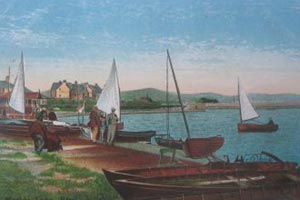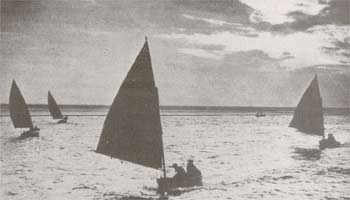It was in 1912 that the newly formed Boat Racing Association (BRA) launched a competition for the design of a small sailing and rowing dinghy which would be equally at home serving as a tender to a larger vessel or taking part in club races. The vessel should have an overall length of 12 feet, a beam of 4 feet 6 inches and a single sail of 100 square feet. The hull was to be clinker, planked in spruce on bent timbers. The competition was won by George Cockshott, an amateur boat designer from Southport, Lancashire, who had previously won prizes in other yacht and boat design competitions.
The design was baptised the ‘A’ Class One Design Dinghy but soon became known as the BRA 12 foot class. Following a few modifications the first orders were placed. By October 1913 the members of the West Kirby Sailing Club had already taken receipt of six BRA 12 dinghies. At West Kirby the design was again re-christened when it became known locally as the Dreadnought Class, with the entire fleet of these diminutive dinghies being named after contemporary British battleships such as the Audacious, Thunderer and Bellerophon. The Royal Engineer’s Yacht Club was another early customer and before long their vessels were spreading throughout the British Empire.

International 12 sailing on the Marine Lake, Rhyl. 1920s postcard published by Delittle, Fenwick & Co.
Soon the design spread to the Netherlands where it was greeted enthusiastically. By the end of the First World War there was a fleet of 140 BRA 12 footers racing there.
In the early 1920s the BRA merged with the Yacht Racing Association which hitherto had little interest in sailing dinghies. A subsequent International Yacht Racing Union (IYRU) conference decided that the BRA 12 footers should become the International 12 Foot Dinghy Class.
Some BRA members felt that an improved 12-foot dinghy should be designed for post-war use and approached Morgan Giles, one of the UK’s best-known designers of small racing dinghies. Giles redrew the hull lines to allow a greater crew weight and improved sail carrying ability. He also moved the thwarts to improve the trim when the dinghy was being rowed. The new design performed better to windward, especially in light airs, and was stiffer and drier in a breeze. By this time eleven countries were sailing the International 12 Foot Dinghy and most of these were keen to adopt the new design, however the changes where opposed by the Netherlands and Belgium who had the largest fleets of original BRA 12 foot dinghies. Consequently, the International 12 Foot Dinghy Class retained George Cockshott’s pre-war design.

Racing on the Marine Lake, West Kirby, from ‘Anything but Sailing – A history of West Kirby Sailing Club’ by John Millar.
By 1920 the International 12 Foot Dinghy had become the most numerous One-Design class with over 200 boats in the United Kingdom and a large number overseas. The class was given further boosts when it was selected for the 1920 Olympic games in Belgium and again in 1928 when it was used as the single-handed boat for the games held in The Netherlands.